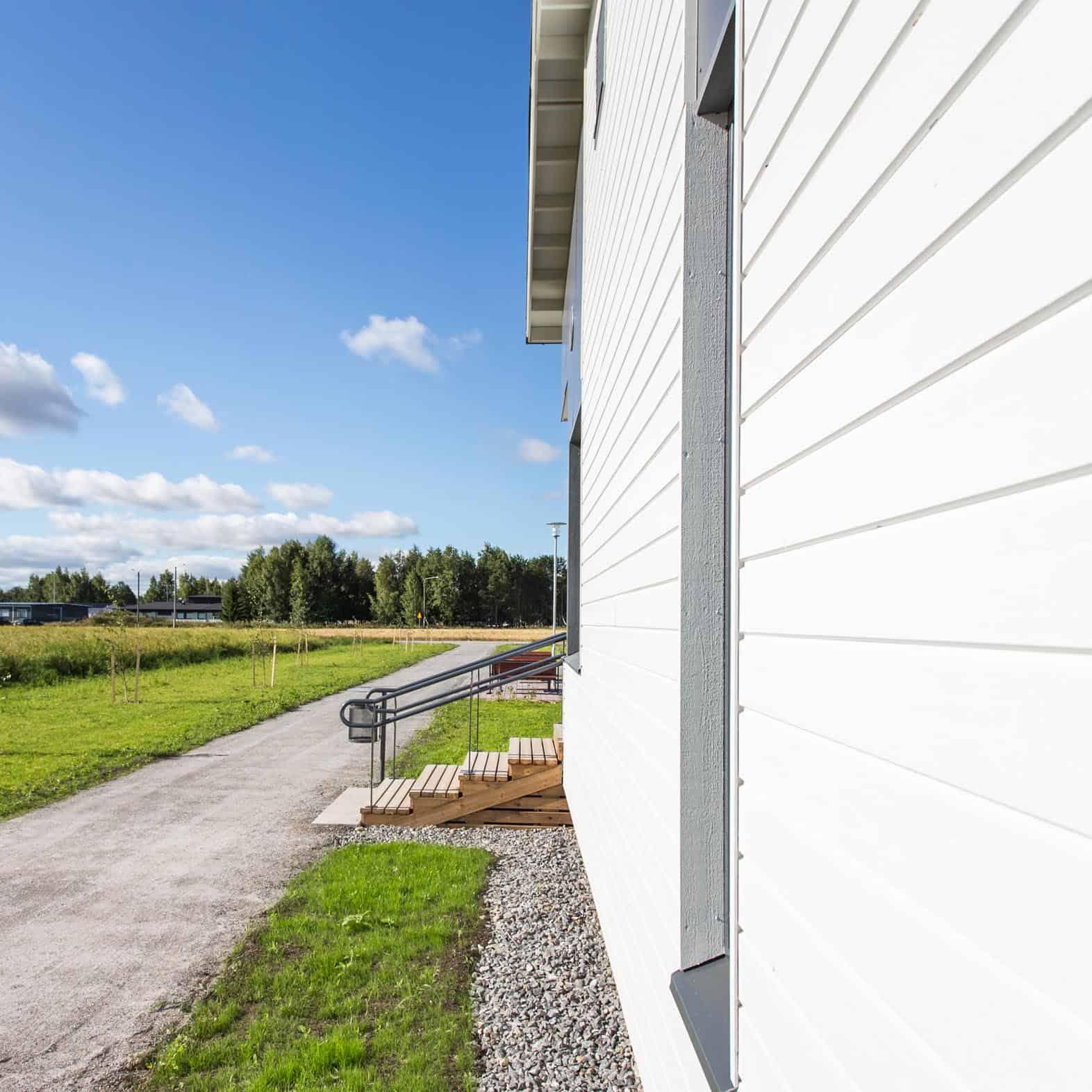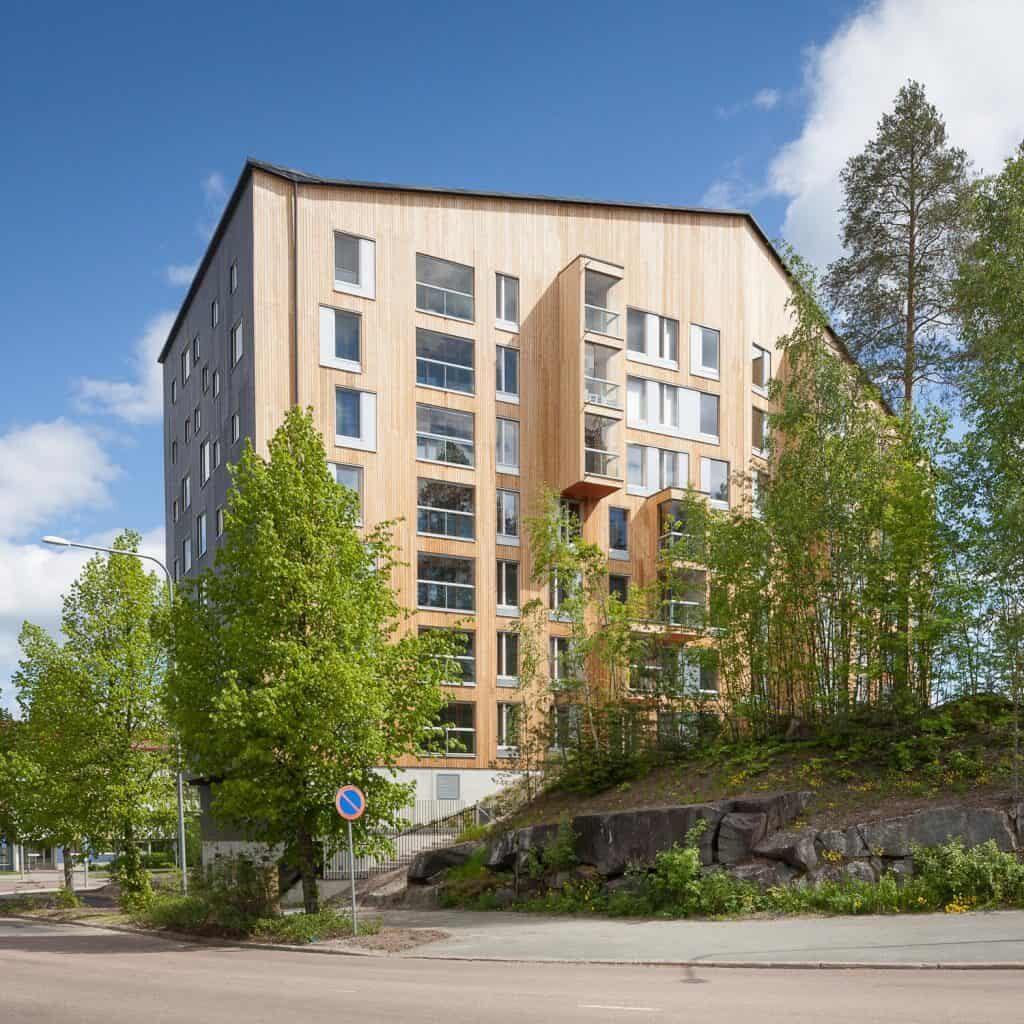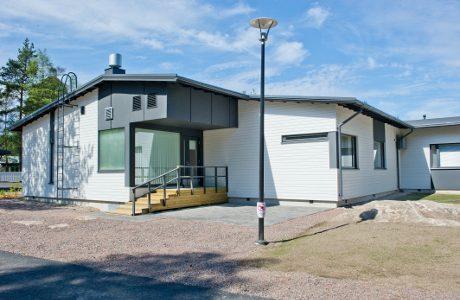In the past, the use of wood in industrial construction has been slowed down by fire safety regulations. Due to strict regulations, it has not been possible to use wood as such in the past, for example in the facades of apartment buildings. Advances in surface treatment methods and materials have brought wood on a par with other building materials. Thanks to its fire-resistance, wooden façades can be used in both apartment buildings and nursing homes.
Construction is governed by a set of regulations and guidelines on fire safety in buildings. The Finnish Building Code contains provisions on fire safety in buildings. The main requirements concern the durability of structures, the limitation of fire spread both inside and around the building and the rescue of persons. The safety of emergency personnel must also be taken into account at the construction stage.
Fire classes
Buildings are divided into three fire classes, of which P1 is the most demanding. The list below shows the requirements of each fire class for the building and the products used in it.
- P1 - The load-bearing structures of the building are assumed to be able to withstand a fire without collapsing. Number of storeys: no limit. Height: no limit
- P2 - A sufficient level of safety is achieved by setting requirements, in particular for surface characteristics and fire safety devices. Number of storeys: 2-8 storeys. Height: up to 26 m.
- P3 - The load-bearing structures of a building of fire class P3 are not subject to specific requirements in terms of fire resistance. Number of storeys: maximum 1. Height: maximum 9 m
Building materials are classified according to the pan-European EN standards, which are used to test and assess the properties of products. Construction products are divided into classes according to their effect on the ignition and spread of fire (classes A1, A2, B, C, D, E, F), smoke generation (s1, s2, s3) and combustible droplets (d0, d1, d2). For the classification of wood products, the requirements of the harmonised product standard EN-14915 (solid wood panels and cladding for exterior and interior use) are followed. Wood products are classified as D-s2, d0.
Fire-resistant wood cladding
To allow the use of wood as cladding in P1 public buildings such as apartment blocks and care homes, its fire-resistance properties need to be improved. The table below summarises the requirements for wood with regard to its fire resistance properties for different types of buildings. Wood as a material is automatically classified as class D-s2, d0. The surface treatment of the external cladding panel can protect the wood against fire and slow down the spread of fire.
According to the fire classification, wood smoke extraction and the presence of combustible droplets in a fire are already inherently good. The primary objective of wood fire protection is therefore to limit the contribution of wood materials to the fire. Fire protection of wood must be carried out under strictly controlled conditions, in accordance with a production process that has been verified by an external operator. Wood fire protection uses a water-based paint that expands under heat to form an insulating foam layer and thus slows down the fire. The paint manufacturer must also have the properties of the paint approved by an external, accredited testing institute, which will approve the paint to the highest fire class.
P1 buildings: B1-s1, d0
Residential and office buildings up to 8 storeys: B1,s2, d0
P2 care facilities: B1,s2, d0
Residential and office buildings 3-8 storeys: B1,s2, d0
Other P2 and P3 buildings: D-s2, d0
B= equipment with a very limited contribution to the fire
D= equipment whose contribution to the fire is acceptable
s1= very low smoke production
s2= low smoke production
d0= no combustible droplets or fragments present
d1= Burning droplets or parts are extinguished quickly
It is worth noting that in a building of class P1 up to 8 storeys, the external part of the external wall surface may be of class D-s2, d2, provided that the structures surrounding such parts protect the wall surface from the spread of fire. Wood may therefore be used as part of the façade without fire protection even in P1 buildings. In the case of residential or commercial buildings of 4 storeys or less, or residential or commercial buildings of 8 storeys or less equipped with an automatic fire extinguishing system, external cladding panels of class D-s2, d2 may be used on the external face of the external wall. However, in this case the lowest floor of the building, exits, emergency exits and above and below windows and other openings shall be of other materials.
Make sure that the fire-resistant wood is CE marked
With the CE marking, the manufacturer demonstrates that the essential characteristics of the product have been examined and comply with the product requirements. The Ce marking requires that the characteristics of the product are set out in a declaration of performance. The declaration of performance indicates the declared values and classes of the product's characteristics, including, among others, the indication of the fire class.
The CE marking for fire-resistant cladding requires that the factory's production process is regularly inspected by an external inspection authority. This ensures that the cladding is safe to use and meets the required standards.
The most recent project completed this spring is the 6-storey wooden apartment building Joensuun Pihapetäjä in Penttilkä, Joensuu, which uses fire-resistant cladding on its facades. Siparila's fire-resistant facade panels have also been used in the following buildings:
- Hovila Youth Home, Jyväskylä
- Kyrönmaa Service Home, Tervajoki
- Puukuokka, Jyväskylä
- Rauma Service House, Rauma




